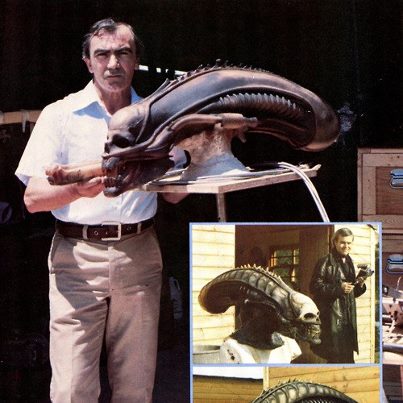If one asked filmgoers what they immediately visualise at the mention of Ridley Scott’s Alien (1979) and Steven Spielberg’s ET: The Extra-Terrestrial (1982), the majority would most likely name the creatures in the title roles – disgustingly malevolent in the former, and ugly but cuddly in the latter. The special effects artist Carlo Rambaldi, who has died aged 86, was almost entirely credited with creating the character of ET, not only conceptually but also physically, and with actualising HR Giger’s designs for the murderous alien loose on a space ship. Rambaldi’s work on these two blockbusters was recognised with Academy Awards (shared) for visual effects. For King Kong (1976), he shared a special achievement Oscar.
On the surface, these lauded, large-scale Hollywood movies seemed a world away from Rambaldi’s beginnings as a designer, model maker and special effects man on rather tawdry low-budget Italian horror movies. However, there was a natural progression in his career, from cheap monsters to more expensive ones.
Rambaldi was born in Vigarano Mainarda, north-east Italy. After graduating from the Academy of Fine Arts in Bologna in 1951, he made a living as a commercial artist. His first venture into films was as the uncredited designer of an effective fire-breathing dragon who confronts the hero in Sigfrido (The Dragon’s Blood, 1957). Made six years later, Perseo l’Invincibile (Perseus Against the Monsters, aka Medusa vs the Son of Hercules) was a better than average sword-and-sandal saga, with a dragon that lives in a lake, and a tree-like, one-eyed monster, the Medusa, which moves on spidery roots and has a thick nest of tentacles for hair, courtesy of Rambaldi.
He spent the next 10 years steeped in blood by creating eerie special effects for the films of Italian schlock horror “giallo” maestros such as Mario Bava, Damiano Damiani, Lucio Fulci and Dario Argento. For Bava, Rambaldi conceived disembodied aliens taking over the corpses of dead astronauts in Terrore nello Spazio (Planet of the Vampires, 1965) and for Reazione a Catena (A Bay of Blood, aka Twitch of the Death Nerve, 1971), often cited as the first slasher movie, he found ingenious ways of making the multiple killings by machete look convincing. Fulci’s Una Lucertola con la Pelle di Donna (Lizard in a Woman’s Skin, 1971) landed the director in court over an unusually ugly scene of vivisected dogs (during a hallucination), but he was saved from two years in prison for animal cruelty when Rambaldi brought in the animatronic models of the dogs as evidence.
Rambaldi was a pioneer of animatronics (puppets operated mechanically by rods or cables) and mechatronics, which combined mechanical, electronic and system design engineering, all in the days before digital special effects became ubiquitous. “The mystery’s gone. It’s as if a magician had revealed all of his tricks,” he said, expressing his disdain for the digital age. “Digital costs around eight times as much as mechatronics. ET cost a million dollars and we created it in three months. If we wanted to do the same thing with computers, it would take at least 200 people a minimum of five months.” To realise the little extraterrestrial, which was capable of 150 separate moves, Rambaldi used steel, polyurethane, rubber, and hydraulic and electronic controls.
Rambaldi, who had worked on Flesh for Frankenstein (aka Andy Warhol’s Frankenstein,1973) and Blood for Dracula (Andy Warhol’s Dracula, 1974), Italian co-productions shot back-to-back in Serbia, was invited to the US by Dino De Laurentiis, who was producing his 1976 remake of King Kong. De Laurentiis had been impressed by Rambaldi’s special effects in Argento’s stylish thriller Profondo Rosso (Deep Red, 1975).
Rambaldi soon built his reputation in America with Close Encounters of the Third Kind (1977) and Alien. “He designed the mechanics of the head, made the lips work, made the jaws function,” Scott recalled of the latter. “Normally you can’t stand to have the camera take a close look at things like this, but it was so good I just did a huge close up on it.”
Around the time he reached the peak of his career with ET, Rambaldi contributed to Andrzej Zulawski’s Possession (1981), David Lynch’s Dune (1984) and Richard Fleischer’s Conan the Destroyer (1984). The last film in which he did special effects was Primal Rage (1988); a throwback to the giallo movies of the 60s and early 70s, it was directed by his son Vittorio Rambaldi.

